Thinking Big While Going Green
Step into the custom, energy-efficient house of Judy and Allen Lipis in Toco Hills.
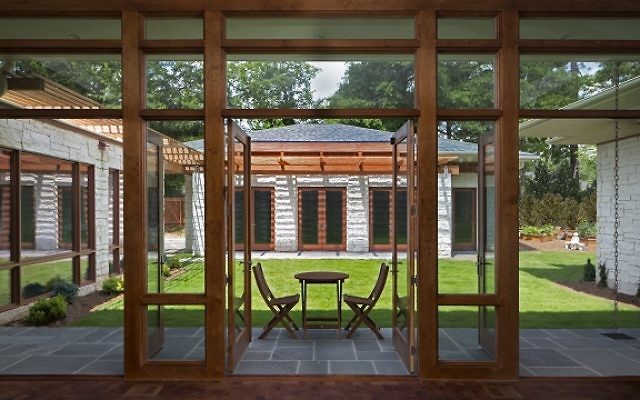
Judy and Allen Lipis took their time in creating a custom, energy-efficient house in the Toco Hills area. Using Jerusalem-like stone on the exterior and interior, the home sparkles with natural light, Jewishly observant touches and sustainability.
Judy and Allen’s backgrounds lend themselves to this efficiency and precision.
Judy is a retired middle school science teacher who reigns over her garden and dotes over her grandchildren.
Allen, who has a degree from the University of Pennsylvania in operations research, made his mark as a pioneer the technology of electronic banking.
He was transferred to Atlanta in 1971 by Citibank on loan to Georgia Tech for one year. He stayed on to consult with the five major banks on payment systems on the implementation of the Automated Clearing House and the study of debit cards before they existed. Much of Allen’s genius in automation is in use today at the Federal Reserve System and for Social Security electronic payments.
Allen, now retired, serves on the boards of two companies: one in the beer industry, the other in movie production. He also writes a monthly column for the AJT.
Judy, retired in 2002, takes pride in motivating Atlanta Jewish Academy students in all areas of science. She said, “Middles-schoolers were just at the right age to be creative as youngsters, but armed with the logic and tools that come with a bit of age and experience.”

Jaffe: What are some of the unusual features of your house?
Allen: We used white limestone from Austin, Texas, that looks like Jerusalem stone on the entire exterior and the interior, as well as the garage, lots of windows, including clerestory windows (122 in total) at the roofline, three French doors on the front of house, three at the back of house and three on the garage behind the house — all in line with each other.
Jaffe: What makes the house environmentally special?
Allen: We have a geothermal HVAC system, an end-grain mesquite floor for the kitchen and the great room, end-grain Douglas fir flooring for all bedrooms and offices. This flooring from Oregon is the crosscut from the circular part of the tree, composed of 4-inch squares which show the rings, with each square looking different.
The geothermal system required drilling down 200 feet into the ground, where it is 57 to 60 degrees. During the winter, it absorbs heat stored in the ground through the water that circulates in its underground loop. This heat is carried to the ground-source heat pumps, where it’s concentrated and sent as warm, comfortable air throughout our home. During the summer, the system absorbs heat from our home and transfers it to the underground loop, where it is absorbed by the cooler earth. The geothermal heat pump uses the cool water returning from the ground to create cool, dehumidified air conditioning. We have no compressor, and this saves money.
Jaffe: How would you describe the layout?
Allen: The garage is behind the house, which creates a private courtyard. We have a pergola designed to serve as a sukkah and pervious pavers for the entire driveway. The front entrance makes a statement with three sets of steps in line with our French doors. The overall house design fits the style of Frank Lloyd Wright.
Jaffe: What was unique about your workforce?
Allen: We made every effort to employ Jewish subcontractors: Aardvark (electrician), Peyton Alexander (garage door, gutters and rain chain), Arts & Laminates’ Israel Peljovich (custom cabinets) and Trevor Jackson (Taj Mahal countertops). We used Black Tie Builders (Shimon Afrah and David Behdadnia) to implement the project, designed by Stephen Flanagan.
Steve Flanagan (architect): There are a number of unique elements to the home. The big idea was to create an architectural expression that both reflected the Lipises’ gracious personalities and was simultaneously a contemporary expression of Jewish traditions that are interwoven in their lives. One of the keys was having the entire roof float just above the walls on a thin band of clerestory glass, as a kippah similar to the one that lightly rests on a Jewish man’s head. Allen and Judy wanted a low-maintenance exterior, so I used a Jerusalem stone look, coupled with a lot of glass to blur the boundaries and allow light in and views out. The main idea was to create a courtyard, a space in between the house and the garage where Judy could garden and where the rest of the house could face as a precious jewel at the heart of their home.

Israel Peljovich: I used white maple throughout. The kitchen is unbelievable with self-closing cabinets, a unique spice rack and clever pop-ups, like the heavy mixer that Judy doesn’t have to bend over to lift.
Judy, who is an avid knitter, wanted a place to store her yarns. We designed a beehive matrix with hexagons that lines her study wall.
The master bedroom has a swiveling leather headboard and cabinets, a bookcase, nightstands and dressers that were stained and lacquer-finished to match the floor.
Jaffe: Were there any snags along the way?
Judy: With windows at the roof, we needed a steel structure instead of wood to hold up the roof. Initially, the steel was not perfectly lined up, so several uprights had to be moved. We also didn’t know how much stone to buy and eventually had three deliveries of stone from Texas. In the end, after two years, three months, 22 days (but who’s counting?), we have a gorgeous home that we love and are thankful for the professionalism that the workers provided.
Jaffe: Your home was recently on the Hadassah Tour of Kitchens. It is built to last and shine on as an example of modernity and practicality.
Allen: Building your own home can be an awesome challenge and a marvelous reward. I liked the process, but Judy preferred the result.
Photos by Stephen Flanagan, Studio One Architecture
- This image is copyrighted and registered with the U.S. Copyright Office in the Library of Congress. Unauthorized use prohibited. All rights reserved.
- This image is copyrighted and registered with the U.S. Copyright Office in the Library of Congress. Unauthorized use prohibited. All rights reserved.
- The kitchen houses a separate wall where prayers can be placed, shadowing the Western Wall in Jerusalem.
- This image is copyrighted and registered with the U.S. Copyright Office in the Library of Congress. Unauthorized use prohibited. All rights reserved.
- The kitchen has custom cabinets made of Canadian maple and wood flooring composed of squares crosscut from Oregon trees to show the rings. Each square is unique.
- This image is copyrighted and registered with the U.S. Copyright Office in the Library of Congress. Unauthorized use prohibited. All rights reserved.
- The placement of the garage in back creates a private courtyard behind the house. Architect Steve Flanagan says he used glass to allow maximum light and views. (Photo by Stephen Flanagan, Studio One Architecture).
- The house glows at night, showcasing three sets of steps in line with French doors in the Frank Lloyd Wright-style design.
- Allen and Judy Lipis enjoy the harvest of their vegetable and herb garden.





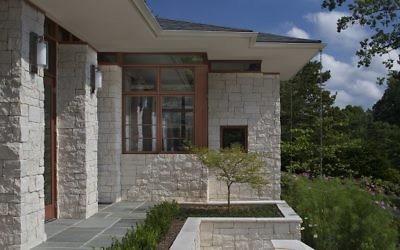
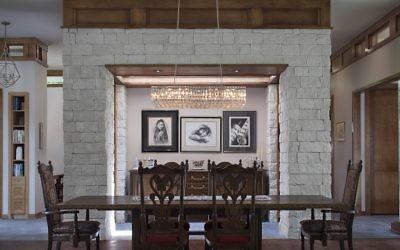
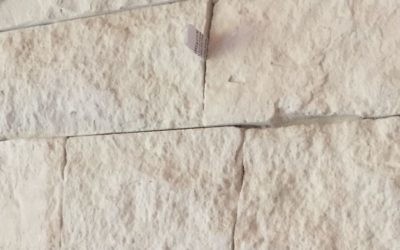
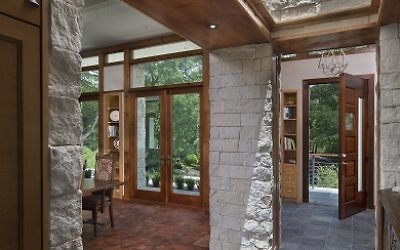
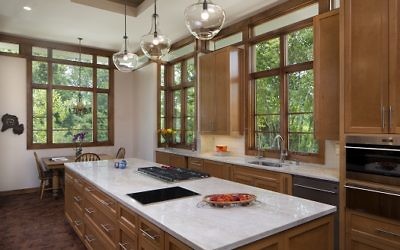
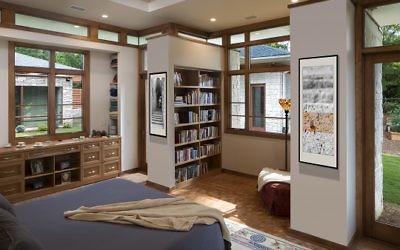
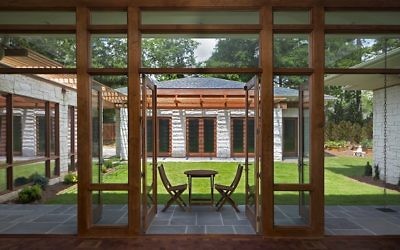
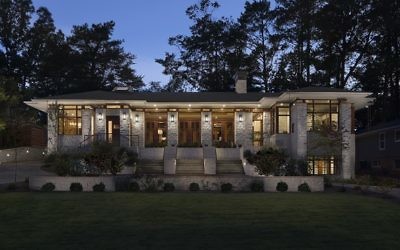
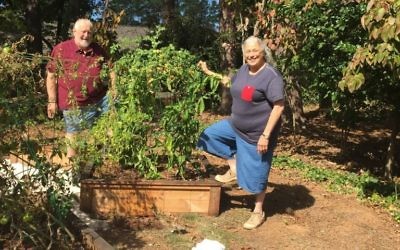
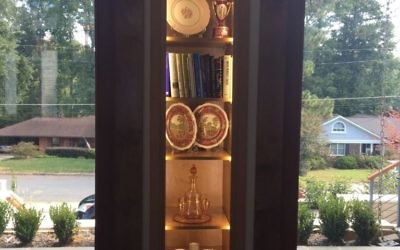
comments